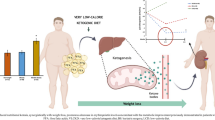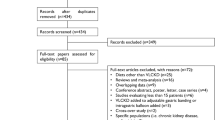Abstract
The aim of the present study was to compare the effects of a low-fat diet enriched with oleic acid to those of a low-fat diet enriched with linoleic acid on fasting lipids, postprandial lipemia, and oxidative susceptibility of low-density lipoprotein (LDL) in patients with type 2 diabetes mellitus (DM). In a 3-wk randomized crossover study, eight patients with type 2 DM were given an experimental low-fat diet enriched with either oleic acid or linoleic acid. The oleic-acid-enriched diet contained 5, 15, and 5% energy from saturated, monounsaturated, and polyunsaturated fatty acids, and the linoleic-acid-enriched diet contained 5, 5, and 15% energy from saturated, monounsaturated, and polyunsaturated fatty acids, respectively. In addition to evaluating the fasting lipids and oxidative susceptibility of LDL, we evaluated postprandial lipemia using an oral fat load at the end of each 3-wk dietary phase. There were no significant differences in fasting lipid profile or lag time of LDL oxidation between the two experimental dietary phases. The average and maximal increments of remnant-like particle (RLP) cholesterol levels during oral fat load were significantly higher after the oleic-acid-enriched dietary phase than after the linoleic-acid-enriched dietary phase. The area under the curve of RLP cholesterol was also significantly larger after the oleicacid-enriched dietary phase than after the linoleic-acid-enriched dietary phase. These results suggest that the oleic-acidenriched diet was associated with increased formation of postprandial chylomicron remnants compared with the linoleicacid-enriched diet.
Similar content being viewed by others
Abbreviations
- apo:
-
apolipoprotein
- AUC:
-
area under the curve
- CHD:
-
coronary heart disease
- DM:
-
diabetes mellitus
- FFA:
-
free fatty acid
- HDL:
-
high density lipoprotein
- HPLC:
-
high-performance liquid chromatography
- LDL:
-
low density lipoprotein
- LPL:
-
lipoprotein lipase
- LPO:
-
lipid peroxidation
- PBS:
-
phosphate-buffered saline
- RLP:
-
remnant-like particles
- TG:
-
triglyceride
References
Chen, Y.D., Swami, S., Skowronski, R., Coulston, A., and Reaven, G.M. (1993) Differences in Postprandial Lipemia Between Patients with Normal Glucose Tolerance and Noninsulin-Dependent Diabetes Mellitus, J. Clin. Endocrinol. Metab. 76, 172–177.
Syvänne, M., Hilden, H., and Taskinen, M.R. (1994) Abnormal Metabolism of Postprandial Lipoproteins in Patients with Non-Insulin-Dependent Diabetes Mellitus Is Not Related to Coronary Artery Disease, J. Lipid Res. 35: 15–26.
Mero, N., Syvänne, M., and Taskinen, M.R. (1998) Postprandial Lipid Metabolism in Diabetes, Atherosclerosis 141, S53–S55.
Lefebure, P.J., and Scheen, A.J. (1998) The Postprandial State and Risk of Cardiovascular Disease, Diabetes Med. 15, S63–S68.
Miesenböck, G., and Patsch, J.R. (1992) Postprandial Hyperlipidemia: The Search for the Atherogenic Lipoprotein, Curr. Opin. Lipidol. 3, 196–201.
Patsch, J.R., Miesenböck, G., Hopferwieser, T., Muhlberger, V., Knapp, E., Dunn, J.K., Gotto, A.M., Jr., and Patsh, W. (1992) Relation of Triglyceride Metabolism and Coronary Artery Disease. Studies in the Postprandial State, Arterioscler. Thromb. Vasc. Biol. 12, 1336–1345.
Karpe, F., Steiner, G., Uffelman, K., Olivecrona, T., and Hamsten, A. (1994) Postprandial Lipoproteins and Progression of Coronary Atherosclerosis, Atherosclerosis 106, 83–97.
Georgopoulos, A., Kafonek, S.D., and Raikhei, I. (1994) Diabetic Postprandial Triglyceride-Rich Lipoproteins Increase Cholesterol Ester Accumulation in THP-1 Macrophages, Metabolism 43:1063–1072.
Shige, H., Ishikawa, T., Ikewaki, K., Nishiwaki, M., Higashi, K., Nakajima, K., and Nakamura, H. (1997) Remnant-Like Very-Low-Density Lipoproteins Isolated from Hypertriglyceridemic Patients by Immunoaffinity Chromatography Suppressed 3-Hydroxy-3-Methylglutaryl Coenzyme A Activity of Cultured Human Skin Fibroblasts, Clin. Chim. Acta 258, 145–158.
Nakajima, K., Saito, T., Tamura, A., Suzuki, M., Nakano, T., Adachi, M., Tanaka, A., Tada, N., Nakamura, H., Campos, H., et al. (1993) Cholesterol In Remnant-Like Lipoproteins in Human Serum Using Monoclonal Anti Apo B-100 and Apo A-I Immunoaffinity Mixed Gels, Clin. Chim. Acta 223, 53–71.
Devaraj, S., Vega, G., Lange, R., Grundy S.M., and Jialal, I. (1998) Remnant-Like Particle Cholesterol Levels in Patients with Dysbetalipoproteinemia or Coronary Artery Disease, Am. J. Med. 104, 445–450.
McNamara, J.R., Shah, P.K., Nakajima, K., Cuppeles, L.A., Wilson, P.W., Ordovas, J.M., and Schaefer, E.J. (1998) Remnant Lipoprotein Cholesterol and Triglyceride Reference Ranges from the Framingham Heart Study, Clin. Chem. 44, 1224–1232.
Kugiyama, K., Doi, H., Takazoe, K., Kawano, H., Soejima, H., Mizuno, Y., Tsunoda, R., Sakamoto, T., Nakano, T., Nakajima, K., et al. (1999) Remnant Lipoprotein Levels in Fasting Serum Predict Coronary Events in Patients with Coronary Artery Disease, Circulation 99, 2858–2860.
Tanaka, A., Tomie, N., Nakano, T., Nakajima, K., Yui, K., Tamura, M., and Numano, F. (1998) Measurement of Postprandial Remnant-Like Particles (RLPs) Following a Fat-Loading Test, Clin. Chim. Acta 275:43–52.
Nakamura, H., Ikewaki, K., Nishiwaki, M., and Shige, H. (1995) Postprandial Hyperlipemia and Coronary Artery Disease, Ann. NY Acad. Sci. 748:441–446.
Mattson, F.H., Grundy, S.M. (1985) Comparison of Effects of Dietary Saturated, Monounsaturated, and Polyunsaturated Fatty Acids on Plasma Lipids and Lipoproteins in Man, J. Lipid Res. 26:194–202.
Reaven, P., Parthasarathy, S., Grasse, B.J., Miller, E., Almazan, F., Mattson, F.H., Khoo, J.C., Steinberg, D., and Witztum, J.L. (1991) Feasibility of Using an Oleate-Rich Diet to Reduce the Susceptibility of Low Density Lipoprotein to Oxidative Modification in Humans, Am. J. Clin. Nutr. 54:701–706.
Bonanome, A., Pagnan, A., Biffanti, S., Opportuno, A., Sorgato, F., Dorella, M., Maiorino, M., and Ursini, F. (1992) Effect of Dietary Monounsaturated and Polyunsaturated Fatty Acids on Susceptibility of Plasma Low Density Lipoproteins to Oxidative Modification, Arterioscler. Thromb. 12:529–533.
Higashi, K., Ishikawa, T., Shige, H., Tomiyasu, K., Yoshida, H., Ito, T., Nakajima, K., Yonemura, A., Sawada, S., and Nakamura, H. (1997) Olive Oil Increases the Magnitude of Postprandial Chylomicron Remnants Compared to Milk Fat and Safflower Oil, J. Am. Coll. Nutr. 16:429–434.
Georgopoulos, A., Bantle, J.P., Noutson, M., Swaim, W.R., and Parker, S.J. (1998) Differences in the Metabolism of Postprandial Lipoproteins After a High-Monounsaturated-Fat Vs. a High-Carbohydrate Diet in Patients with Type 1 Diabetes Mellitus, Arterioscler. Thromb. Vasc. Biol. 18, 773–782.
Esterbauer, H., Striegl, G., Puhl, H., and Rotheneder, M. (1989) Continuous Monitoring of in vitro Oxidation of Human Low Density Lipoprotein, Free Radicals Res. Commun. 6, 67–75.
Inomata, N. (1974) Simple and Rapid Method of Analysis of Fatty Acid Components of Serum Lipids (in Japanese), Rinsho byori 22 (10 suppl.), 146.
Hales, C.N., and Randle, P.J. (1963) Immunoassay of Insulin with Insulin Antibody Precipitate, Biochem. J. 88:137–146.
Nydahl, M.C., Gustafsson, I.B., and Vessby, B. (1994) Lipid-Lowering Diets Enriched with Monounsaturated or Polyunsaturated Fatty Acids but Low in Saturated Fatty Acid Have Similar Effects on Serum Lipid Concentrations in Hyperlipidemic Patients, Am. J. Clin. Nutr. 59:115–122.
Roche, H.M., Zampelas, A., Knapper, J.M., Webb, D., Brooks, C., Jackson, K.G., Wright, J.W., Gould, B.J., Kafatos, A., Gibney, M.J., et al. (1998) Effect of Long-Term Olive Oil Dietary Intervention on Postprandial Triglycerol and Factor VII Metabolism, Am. J. Clin. Nutr. 68:552–560.
Larsen, L.F., Jespersen, J., and Marckmann, P. (1999) Are Olive Oil Diets Antithrombotic? Diets Enriched with Olive, Rapeseed, or Sunflower Oil Affect Postprandial Factor VII Differently, Am. J. Clin. Nutr. 70, 976–982.
van Greevenbroek, M.M., van Meer, G., Erkelens, D.W., and de Bruin, T.W. (1996) Effects of Saturated, Mono-, and Polyunsaturated Fatty Acids on the Secretion of ApoB Containing Lipoproteins by Caco-2 Cells, Atherosclerosis 121:139–150.
Dixon, J.L., Furukawa, S., and Ginsberg, H.N. (1991) Oleate Stimulates Secretion of Apo B Containing Lipoproteins from HepG2 Cells by Inhibiting Early Intracellular Degradation of Apo B, J. Biol. Chem. 266:5080–5086.
Mustad, V.A., Ellsworth, J.L., Cooper, A.D., Kris-Etherton, P.M., and Etherton, T.D. (1996) Dietary Linoleic Acid Increases and Palmitic Acid Decreases Hepatic LDL Receptor Protein and mRNA Abundance in young pigs, J. Lipid. Res. 37:2310–2323.
Sato, M., Yoshida, S., Nagao, K., and Imaizumi, K. (2000) Superiority of Dietary Safflower Oil over Olive Oil in Lowering Serum Cholesterol and Increasing Hepatic mRNAs for the LDL Receptor and Cholesterol 7alpha-Hydroxylase in Exogeneous Hypercholesterolemic (exHC) Rats, Biosci. Biotechnol. Biochem. 64:1111–1117.
Mahley, R.W., and Ji, Z.S. (1999) Remnant Lipoprotein Metabolism: Key Pathways Involving Cell-Surface Heparan Sulfate Proteoglycans and Apolipoprotein E, J. Lipid Res. 40:1–16.
Schwab, U.S., Vogel, S., Lammi-Keefe, C.J., Ordovas, J.M., Schaefer, E.J., Li, Z., Ausman, L.M., Gualtieri, L., Goldin, B.R., Furr, H.C., et al. (1998) Varying Dietary Fat Type of Reduced-Fat Diets Has Little Effect on the Susceptibility of LDL to Oxidative Modification in Moderately Hypercholesterolemic Subjects, J. Nutr. 128:1703–1709.
Author information
Authors and Affiliations
Corresponding author
About this article
Cite this article
Higashi, K., Shige, H., Ito, T. et al. Effect of a low-fat diet enriched with oleic acid on postprandial lipemia in patients with type 2 diabetes mellitus. Lipids 36, 1–6 (2001). https://doi.org/10.1007/s11745-001-0660-5
Received:
Revised:
Accepted:
Issue Date:
DOI: https://doi.org/10.1007/s11745-001-0660-5




